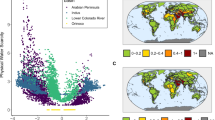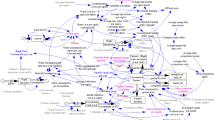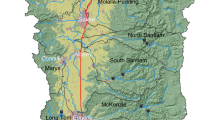Abstract
Water markets have the potential to lessen some costs of climate change. However, they need to be designed to address the unique institutional and physical features of water. In this Perspective, we discuss the role water markets could play in adapting to climate change and outline opportunities for moving forward. We draw on the environmental economics literature to highlight past challenges with water markets and environmental markets more generally, and identify opportunities for water-specific market design. We argue that water markets will serve to improve adaptation if they are designed with these key features in mind.
This is a preview of subscription content, access via your institution
Access options
Access Nature and 54 other Nature Portfolio journals
Get Nature+, our best-value online-access subscription
$29.99 / 30 days
cancel any time
Subscribe to this journal
Receive 12 print issues and online access
$209.00 per year
only $17.42 per issue
Buy this article
- Purchase on Springer Link
- Instant access to full article PDF
Prices may be subject to local taxes which are calculated during checkout

Similar content being viewed by others
References
Swain, D. L., Langenbrunner, B., Neelin, J. D. & Hall, A. Increasing precipitation volatility in twenty-first-century California. Nat. Clim. Change 8, 427–433 (2018).
Arias, P. et al. in Climate Change 2021: The Physical Science Basis (eds Masson-Delmotte, V. et al.) 33–144 (IPCC, Cambridge Univ. Press, 2021).
State and Trends of Carbon Pricing 2020 (The World Bank, 2020).
Nogrady, B. et al. China launches world’s largest carbon market: but is it ambitious enough? Nature 595, 637 (2021).
Colmer, J., Martin, R., Muûls, M. & Wagner, U. J. Does pricing carbon mitigate climate change? Firm-level evidence from the European Union Emissions Trading Scheme. SSRN https://ssrn.com/abstract=4026889 (2023).
Costello, C., Gaines, S. D. & Lynham, J. Can catch shares prevent fisheries collapse? Science 321, 1678–1681 (2008).
Fowlie, M., Holland, S. P. & Mansur, E. T. What do emissions markets deliver and to whom? Evidence from Southern California’s NOx trading program. Am. Econ. Rev. 102, 965–993 (2012).
Shortle, J. & Horan, R. D. Policy instruments for water quality protection. Annu. Rev. Resour. Econ. 5, 111–138 (2013).
Deschenes, O., Greenstone, M. & Shapiro, J. S. Defensive investments and the demand for air quality: evidence from the NOx budget program. Am. Econ. Rev. 107, 2958–2989 (2017).
Aldy, J. E., Auffhammer, M., Cropper, M., Fraas, A. & Morgenstern, R. Looking back at 50 years of the Clean Air Act. J. Econ. Lit. 60, 179–232 (2022).
Archibald, S. O. & Renwick, M. E. in Markets for Water: Potential and Performance (eds Easter, K. W. et al.) 95–117 (Springer, 1998).
Garrick, D. & Aylward, B. Transaction costs and institutional performance in market-based environmental water allocation. Land Econ. 88, 536–560 (2012).
Libecap, G. D. in New Institutional Economics: A Guidebook (eds Brousseau, E. & Glachant, J.-M.) 272–291 (Cambridge Univ. Press, 2008).
Wheeler, S. A. Water Markets: A Global Assessment (Edward Elgar, 2021).
Fowlie, M. & Reguant, M. Challenges in the measurement of leakage risk. Am. Econ. Assoc. Papers Proc. 108, 124–29 (2018).
Muller, N. Z. & Mendelsohn, R. Efficient pollution regulation: getting the prices right. Am. Econ. Rev. 99, 1714–39 (2009).
Baumol, W. J. & Oates, W. The Theory of Environmental Policy (Cambridge Univ. Press, 1988).
Faurès, J.-M., Hoogeveen, J. & Bruinsma, J. The FAO Irrigated Area Forecast for 2030 (FAO, 2002).
Ritchie, H. & Roser, M. Water use and stress. Our World in Data https://ourworldindata.org/water-use-stress (2017).
Molle, F. Water scarcity, prices and quotas: a review of evidence on irrigation volumetric pricing. Irrig. Drain. Syst. 23, 43–58 (2009).
Hagerty, N. What holds back water markets? Transaction costs and the gains from trade. https://hagertynw.github.io/webfiles/Liquid_Constrained_in_California.pdf (2023).
Siebert, S. et al. Groundwater use for irrigation–a global inventory. Hydrol. Earth Syst. Sci. 14, 1863–1880 (2010).
Richey, A. S. et al. Quantifying renewable groundwater stress with grace. Water Resour. Res. 51, 5217–5238 (2015).
Coase, R. H. in Classic Papers in Natural Resource Economics (ed. Gopalakrishnan, C.) 87–137 (Springer, 1960).
Tsur, Y. & Graham-Tomasi, T. The buffer value of groundwater with stochastic surface water supplies. J. Environ. Econ. Manag. 21, 201–224 (1991).
Brill, T. C. & Burness, H. S. Planning versus competitive rates of groundwater pumping. Water Resour. Res. 30, 1873–1880 (1994).
Provencher, B. & Burt, O. The externalities associated with the common property exploitation of groundwater. J. Environ. Econ. Manag. 24, 139–158 (1993).
Brozović, N., Sunding, D. L. & Zilberman, D. On the spatial nature of the groundwater pumping externality. Resour. Energy Econ. 32, 154–164 (2010).
Edwards, E. C. What lies beneath? Aquifer heterogeneity and the economics of groundwater management. J. Assoc. Environ. Resour. Econ. 3, 453–491 (2016).
Birkenbach, A. M., Kaczan, D. J. & Smith, M. D. Catch shares slow the race to fish. Nature 544, 223–226 (2017).
Ayres, A. B., Edwards, E. C. & Libecap, G. D. How transaction costs obstruct collective action: the case of California’s groundwater. J. Environ. Econ. Manag. 91, 46–65 (2018).
Costello, C. & Grainger, C. A. Property rights, regulatory capture, and exploitation of natural resources. J. Assoc. Environ. Resour. Econ. 5, 441–479 (2018).
Drysdale, K. M. & Hendricks, N. P. Adaptation to an irrigation water restriction imposed through local governance. J. Environ. Econ. Manag. 91, 150–165 (2018).
Hsueh, L. Quasi-experimental evidence on the ‘rights to fish:’ the effects of catch shares on fishermen’s days at sea. J. Assoc. Environ. Resour. Econ. 4, 407–445 (2017).
Barnett, T. P. et al. Human-induced changes in the hydrology of the western United States. Science 319, 1080–1083 (2008).
Medellín-Azuara, J. et al. Adaptability and adaptations of California’s water supply system to dry climate warming. Climatic Change 87, 75–90 (2008).
Ficklin, D. L., Null, S. E., Abatzoglou, J. T., Novick, K. A. & Myers, D. T. Hydrological intensification will increase the complexity of water resource management. Earths Future 10, e2021EF002487 (2022).
Albano, C. M. et al. A multidataset assessment of climatic drivers and uncertainties of recent trends in evaporative demand across the continental United States. J. Hydrometeorol. 23, 505–519 (2022).
Edwards, E. C., Cristi, O., Edwards, G. & Libecap, G. D. An illiquid market in the desert: estimating the cost of water trade restrictions in northern Chile. Environ. Dev. Econ. 23, 615–634 (2018).
Hanak, E., Sencan, G. & Ayres, A. California’s Water Market: Fact Sheet (Public Policy Institute of California, 2021).
Hughes, N., Gupta, M., Whittle, L. & Westwood, T. An economic model of spatial and temporal water trade in the Australian Southern Murray-Darling Basin. Water Resour. Res. 59, e2022WR032559 (2023).
Grafton, R. Q., Libecap, G., McGlennon, S., Landry, C. & O’Brien, B. An integrated assessment of water markets: a cross-country comparison. Rev. Environ. Econ. Policy 5, 219–239 (2011).
Pannell, D. & Rogers, A. Agriculture and the environment: policy approaches in Australia and New Zealand. Rev. Environ. Econ. Policy 16, 126–145 (2022).
Zheng, H., Liu, Y. & Zhao, J. Understanding water rights and water trading systems in China: a systematic framework. Water Secur. 13, 100094 (2021).
Regnacq, C., Dinar, A. & Hanak, E. The gravity of water: water trade frictions in California. Am. J. Agric. Econ. 98, 1273–1294 (2016).
Siirila-Woodburn, E. R. et al. A low-to-no snow future and its impacts on water resources in the western United States. Nat. Rev. Earth Environ. 2, 800–819 (2021).
Bjornlund, H. Farmer participation in markets for temporary and permanent water in southeastern Australia. Agric. Water Manag. 63, 57–76 (2003).
Hanak, E. & Stryjewski, E. California’s Water Market, By the Numbers: Update 2012 (Public Policy Institute of California, 2012).
Womble, P. & Hanemann, W. M. Water markets, water courts, and transaction costs in Colorado. Water Resour. Res. 56, e2019WR025507 (2020).
Loch, A., Wheeler, S. A. & Settre, C. Private transaction costs of water trade in the Murray–Darling Basin. Ecol. Econ. 146, 560–573 (2018).
Thompson, B. in A Research Agenda for Water Law (eds Casado Pérez, V. & Larson, R.) 237–266 (Edward Elgar Publishing, 2023).
Ayres, A. et al. Improving California’s Water Market: How Water Trading and Banking can Support Groundwater Management (Public Policy Institute of California, 2021); https://www.ppic.org/publication/improving-californias-water-market
Ge, M., Akhundjanov, S., Oladi, R. & Edwards, E. C. Left in the dust? Pecuniary and environmental externalities in water markets. SSRN https://doi.org/10.2139/ssrn.4596591 (2023).
Ayres, A., Adams, T., Carron, J., Cohen, M. & Saracino, A. Potential impacts of reduced inflows to the Salton Sea: forecasting non-market damages. J. Am. Water Resour. Assoc. 58, 1128–1148 (2022).
Rosegrant, M. W. & Ringler, C. Impact on food security and rural development of transferring water out of agriculture. Water Policy 1, 567–586 (2000).
Hanak, E. Who Should be Allowed to Sell Water in California? Third-Party Issues and the Water Market (Public Policy Institute of California, 2003).
Libecap, G. D. Institutional path dependence in climate adaptation: Coman’s ‘some unsettled problems of irrigation’. Am. Econ. Rev. 101, 64–80 (2011).
Wheeler, S. A., Zuo, A. & Kandulu, J. What water are we really pumping? The nature and extent of surface and groundwater substitutability in Australia and implications for water management policies. Appl. Econ. Perspect. Policy 43, 1550–1570 (2021).
Fowlie, M. L. & Reguant, M. Mitigating emissions leakage in incomplete carbon markets. J. Assoc. Environ. Resour. Econ. 9, 307–343 (2022).
Bigelow, D. P., Chaudhry, A. M., Ifft, J. & Wallander, S. Agricultural water trading restrictions and drought resilience. Land Econ. 95, 473–493 (2019).
Meng, K. & Thivierge, V. Do environmental markets improve allocative efficiency? Evidence from U.S. air pollution. https://vthivierge.github.io/files/efficiency.pdf (2022).
Ross, A. Speeding the transition towards integrated groundwater and surface water management in Australia. J. Hydrol. 567, e1–e10 (2018).
Gao, L., Connor, J., Doble, R., Ali, R. & McFarlane, D. Opportunity for peri-urban perth groundwater trade. J. Hydrol. 496, 89–99 (2013).
Kuwayama, Y. & Brozović, N. The regulation of a spatially heterogeneous externality: tradable groundwater permits to protect streams. J. Environ. Econ. Manag. 66, 364–382 (2013).
Palazzo, A. & Brozović, N. The role of groundwater trading in spatial water management. Agric. Water Manag. 145, 50–60 (2014).
Guilfoos, T., Khanna, N. & Peterson, J. M. Efficiency of viable groundwater management policies. Land Econ. 92, 618–640 (2016).
Bruno, E. M. & Sexton, R. J. The gains from agricultural groundwater trade and the potential for market power: theory and application. Am. J. Agric. Econ. 102, 884–910 (2020).
Bruno, E. M. & Jessoe, K. Missing markets: evidence on agricultural groundwater demand from volumetric pricing. J. Public Econ. 196, 104374 (2021).
Fishman, R., Lall, U., Modi, V. & Parekh, N. Can electricity pricing save india’s groundwater? Field evidence from a novel policy mechanism in Gujarat. J. Assoc. Environ. Resour. Econ. 3, 819–855 (2016).
Smith, S. M., Andersson, K., Cody, K. C., Cox, M. & Ficklin, D. Responding to a groundwater crisis: the effects of self-imposed economic incentives. J. Assoc. Environ. Resour. Econ. 4, 985–1023 (2017).
Bruno, E. M., Jessoe, K. K. & Hanemann, M. The dynamic impacts of pricing groundwater. J. Assoc. Environ. Resour. Econ. https://doi.org/10.1086/728988 (2023).
Chakravorty, U., Dar, M. H. & Emerick, K. Inefficient water pricing and incentives for conservation. Am. Econ. J. Appl. Econ. 15, 319–50 (2023).
California’s Cap and Trade Program Step by Step (Environmental Defense Fund, 2020).
Mieno, T. & Brozović, N. Price elasticity of groundwater demand: attenuation and amplification bias due to incomplete information. Am. J. Agric. Econ. 99, 401–426 (2017).
Grafton, R. Q. & Wheeler, S. A. Economics of water recovery in the Murray-Darling Basin, Australia. Annu. Rev. Resour. Econ. 10, 487–510 (2018).
Holland, S. P. & Yates, A. J. Optimal trading ratios for pollution permit markets. J. Public Econ. 125, 16–27 (2015).
Tietenberg, T. H. Transferable discharge permits and the control of stationary source air pollution: a survey and synthesis. Land Econ. 56, 391–416 (1980).
Fisher-Vanden, K. & Olmstead, S. Moving pollution trading from air to water: potential, problems, and prognosis. J. Econ. Perspect. 27, 147–172 (2013).
Bruno, E. M., Hagerty, N. & Wardle, A. R. in American Agriculture, Water Resources, and Climate Change (eds Libecap, G. D. & Dinar, A.) 343–366 (Univ. Chicago Press, 2023).
Costello, C. & Grainger, C. A. Grandfathering with Anticipation (National Bureau of Economic Research, 2022).
Montgomery, W. D. Markets in licenses and efficient pollution control programs. J. Econ. Theory 5, 395–418 (1972).
Grafton, R. Q. & Williams, J. Rent-seeking behaviour and regulatory capture in the Murray–Darling Basin, Australia. Int. J. Water Resour. Dev. 36, 484–504 (2020).
Goulder, L. H. & Parry, I. W. Instrument choice in environmental policy. Rev. Environ. Econ. Policy 2, 152–174 (2008).
Ryan, N. & Sudarshan, A. Rationing the commons. J. Polit. Econ. 130, 210–257 (2022).
Hearne, R. & Donoso, G. in Water Markets for the 21st Century: What Have We Learned? Global Issues in Water Policy Vol. 11 (eds Easter, K. W. & Huang, Q.) 103–126 (Springer, 2014).
Hartwig, L. D., Jackson, S. & Osborne, N. Trends in Aboriginal water ownership in New South Wales, Australia: the continuities between colonial and neoliberal forms of dispossession. Land Use Policy 99, 104869 (2020).
Arellano-Gonzalez, J. et al. The adaptive benefits of agricultural water markets in California. Environ. Res. Lett. 16, 044036 (2021).
Rafey, W. Droughts, deluges, and (river) diversions: valuing market-based water reallocation. Am. Econ. Rev. 113, 430–471 (2023).
Heard, S., Fienup, M. & Remson, E. et al. The first SGMA groundwater market is trading: the importance of good design and the risks of getting it wrong. Calif. Agric. 75, 50–56 (2021).
Kroetz, K., Sanchirico, J. N. & Lew, D. K. Efficiency costs of social objectives in tradable permit programs. J. Assoc. Environ. Resour. Econ. 2, 339–366 (2015).
Sutherland, S. A. & Edwards, E. C. The impact of property rights to fish on remote communities in alaska. Land Econ. 98, 239–253 (2022).
Gassert, F., Luck, M. & Landis, M. Aqueduct Water Stress Projections: Decadal Projections of Water Supply and Demand Using CMIP5 GCMs (World Resources Institute, 2015).
Luo, T., Young, R. S. & Reig, P. Aqueduct Projected Water Stress Country Rankings (World Resources Institute, 2015); https://www.wri.org/data/aqueduct-projected-water-stress-country-rankings
Brooks, R. & Harris, E. Efficiency gains from water markets: empirical analysis of Watermove in Australia. Agric. Water Manag. 95, 391–399 (2008).
Wheeler, S., Bjornlund, H., Shanahan, M. & Zuo, A. Price elasticity of water allocations demand in the Goulburn–Murray Irrigation District. Aust. J. Agric. Resour. Econ. 52, 37–55 (2008).
Ayres, A. B., Meng, K. C. & Plantinga, A. J. Do environmental markets improve on open access? Evidence from California groundwater rights. J. Polit. Econ. 129, 2817–2860 (2021).
Acknowledgements
We thank L. Hackett, G. Schlauch, A. Wardle and E. Wiseman for helpful comments and research assistance. This work was supported in part by Agriculture and Food Research Initiative Competitive grant numbers 2021-69012-35916 and 2021-68012-35914 from the USDA National Institute of Food and Agriculture.
Author information
Authors and Affiliations
Contributions
E.M.B. and K.J. contributed equally to all aspects of the paper. They jointly conceived, outlined, developed, wrote and revised the paper.
Corresponding author
Ethics declarations
Competing interests
The authors declare no competing interests.
Peer review
Peer review information
Nature Climate Change thanks Eric Edwards and the other, anonymous, reviewer(s) for their contribution to the peer review of this work.
Additional information
Publisher’s note Springer Nature remains neutral with regard to jurisdictional claims in published maps and institutional affiliations.
Rights and permissions
Springer Nature or its licensor (e.g. a society or other partner) holds exclusive rights to this article under a publishing agreement with the author(s) or other rightsholder(s); author self-archiving of the accepted manuscript version of this article is solely governed by the terms of such publishing agreement and applicable law.
About this article
Cite this article
Bruno, E.M., Jessoe, K. Designing water markets for climate change adaptation. Nat. Clim. Chang. 14, 331–339 (2024). https://doi.org/10.1038/s41558-024-01964-w
Received:
Accepted:
Published:
Issue Date:
DOI: https://doi.org/10.1038/s41558-024-01964-w



